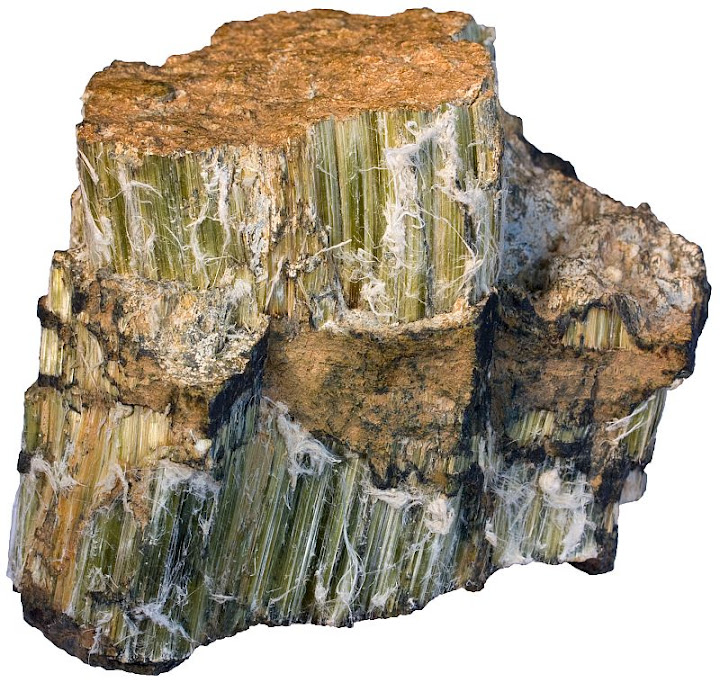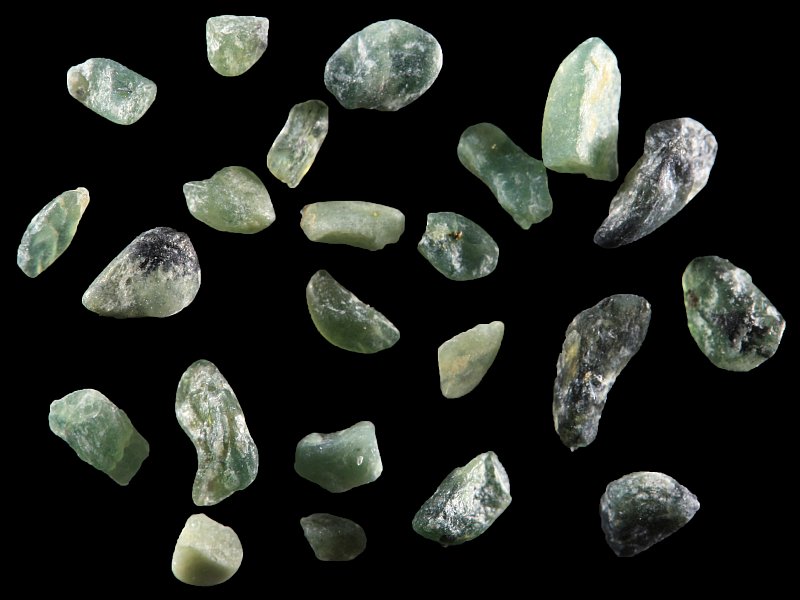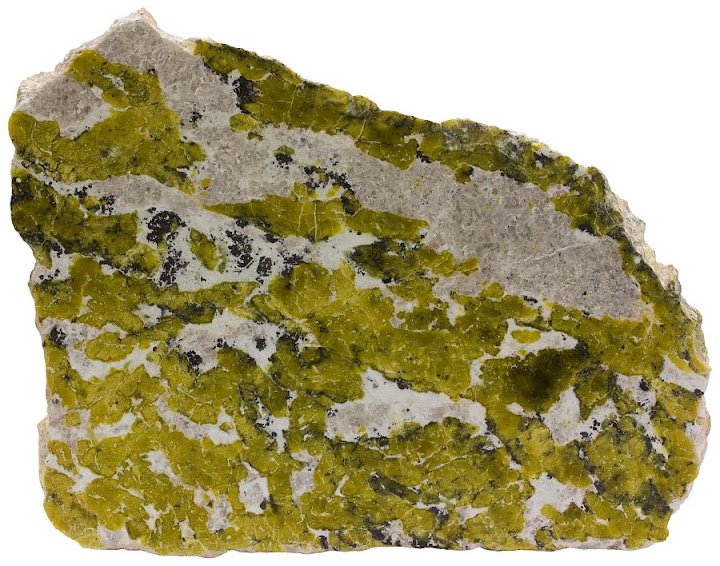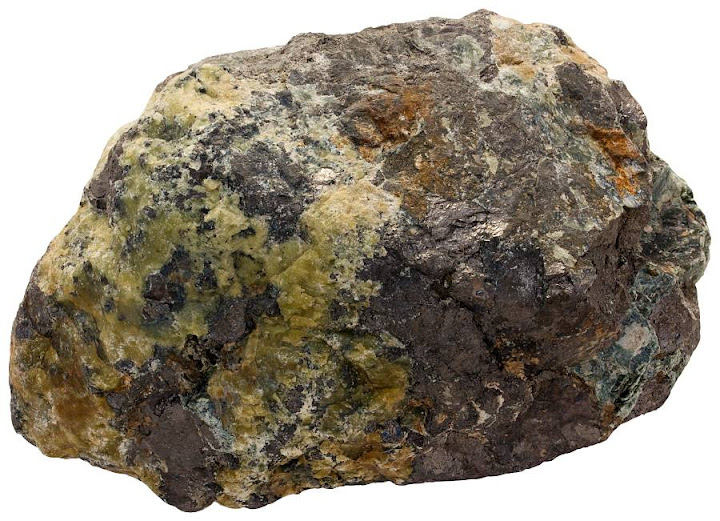Serpentine is a mineral group that contains chrysotile, antigorite, and lizardite. A rock type that is composed mostly of serpentine group minerals is serpentinite. I chose to leave out chrysotile for now because this mineral has distinctly different appearance and properties from the other two. It has a fibrous habit and is the most widely used asbestos mineral. It definitely deserves a separate article. Here I will continue with antigorite and lizardite which are not fibrous and are therefore much better suited to become sand grains.

Fibrous serpentine chrysotile from the Sayan Mountains in Siberia. Width of sample is 8 cm.
Serpentine (Mg3Si2O5(OH)4) is a metamorphic mineral group. It was made at an expense of mafic and especially ultramafic igneous rocks like peridotite and pyroxenite. Such rocks are common in the mantle but quite rare at the surface. When they do crop out, they are often altered by hydrothermal fluids. Hence, we often see meta-peridotite instead of real peridotite. The original mineralogy of the rocks is significantly changed. Rocks that are mostly composed of these minerals are called serpentinites. It often contains all three mineral varieties — fibrous chrysotile veins often alternating with massive antigorite/lizardite. Serpentine may also form in contact metamorphosed carbonate rocks.
Antigorite and lizardite may have a very similar appearance. Thus, there is no reliable method to say which is which in a hand sample. Distinguishing between the two requires more sophisticated approach but even X-ray diffraction may give ambiguous results because they are structurally similar minerals and they tend to occur together.
Antigorite and lizardite are mostly green and they look greasy or waxy. Both light and dark green colors are possible. Mineral grains are darker when they contain more magnetite inclusions. It is easy to make sure that they mostly do contain lots of tiny magnetite crystals because serpentine grains are usually highly susceptible to magnetic field although the mineral itself is not magnetic at all.
Why do they contain magnetite inclusions? To understand that we first have to take a look at the chemical composition of pyroxenes and olivine which are the source material of serpentine. They both usually contain iron but serpentine contains very little iron (its chemical formula contains none but small amount of Mg ions may be replaced with Fe). Most of the iron ions of the precursor minerals are not incorporated into the crystal structure of serpentine, so they tend to form separate iron oxides, most frequently magnetite and hematite.
Antigorite and lizardite may form sand grains but they have only a local importance near the rocks containing these minerals. Serpentine usually alters to chlorite. Good place to look for serpentine are ophiolite sequences. Ophiolite is a piece of oceanic lithosphere that is tectonically pushed on top of the continental crust. The grains below are from a beach sample collected in Corse, France. An ophiolite sequence is exposed there.

Antigorite grains picked from a sand sample collected in Northern Corse near Albo. The darker the grains, the more magnetic they are. The wedge-shaped grain on the left that is significantly darker in the upper corner is an especially good example. It flips its darker side towards the hand magnet if the magnet is slowly moved towards the grain. The width of the view is 17 mm.

Magnesite (white) and serpentine from Norway. Magnesite and serpentine frequently occur together. Magnesite is a magnesium carbonate that forms in low- to medium-grade metamorphic conditions if there was carbon dioxide available. Width of sample 24 cm.

Serpentine minerals occur in skarns. These are metasomatic rocks (metamorphism with extensive change in the bulk chemical composition) that formed as silicic magma reacted with carbonate rocks. Skarns often contain metallic ore minerals and unusual Ca-bearing silicates. Serpentine is widespread here because the host rock is dolomitic marble that provided lots of magnesium. Gray mineral is magnetite (iron oxide). Tapuli, Sweden. Width of sample 11 cm.

Skarn sample consisting of serpentine and hedenbergite (iron-rich Ca-clinopyroxene). Tapuli, Sweden. Width of sample 13 cm.

Skarn with magnetite (gray), serpentine (yellowish green), talc (dark green and micaceous), and calcite (white) as the dominating minerals. Tapuli, Sweden. Width of sample 9 cm.
Why do these minerals have such reptile-like names?
Because their green color resembles the skin color of a serpent or snake. And maybe also because these minerals are waxy like snake scales. However, I don’t know which snake. Green color is not associated with snakes or lizards for me. Does anyone know more about it? In some languages “serpentine” is also a winding mountain road. Not too hard to imagine why.
Your photo reminds me of the first (and so far only) time I saw serpentine “in the wild”. I was working as a wellsite geologist in Costa Rica, on an exploration well. Being used to working with sedimentary rocks, when this beautiful, green, waxy stuff (some of it was asbestiform) started coming up in the cuttings samples, I was completely baffled, until it finally dawned on me that this was serpentine and we had drilled through the sedimentary cover rocks and had penetrated oceanic crust.
Nice story. What were you looking for there? Where else have your field works taken you?
We were looking for oil and/or gas. It was a Petro Canada foreign assistance project to explore sedimentary basins in Costa Rica, in 1988. There had been little to no drilling there previously, so these were pure “wildcat” wells. Very interesting for me, seeing all sorts of new rocks, including lots of volcanic stuff and reworked/redeposited ash, etc. My expertise is sedimentary rocks, so it was a challenge identifying some of the volcanic rocks in cuttings.
All my other work has been in western and northern Canada.
Ah, serpentinite, my favorite rock! I’m lucky to live in the south San Francisco Bay Area, California, USA, where there’s lots of exposed serpentinite (and if you’re willing to drive a bit, there’s a whole ophiolite sequence exposed to the east!)
I’m also a beader by hobby, and I’m fascinated by the “jewelry trade names” for serpentinite. “Serpentine” (well, okay, that’s close), but “new jade”???? Jade is either a pyroxene or an amphibole, not this slippery, easily eroded/worn metamorphic offspring of olivine. (Though there’s nothing quite as pretty as a thin section of olivine half-transformed into serpentine, viewed with crossed polars through a petrographic microscope. But I digress.) Serpentinite beads under any name are cheap, come in lots of variants of mixed or spotted greens, and are my current favorite beading material.